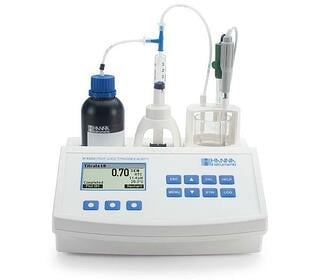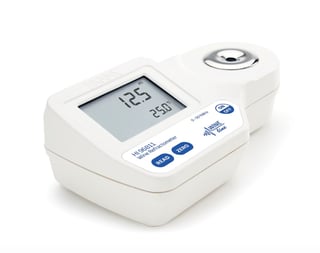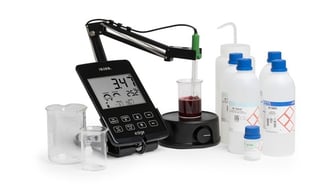
Immediately after harvest season ends and the crushing and pressing begins, fermentation is not too far behind. Wine analysis is critical over the fermentation process.
Fermentation is a process in wine making that must be carefully monitored as it is the process that turns the collected grape juice into wine. As winemakers make their way through the fermentation process, Hanna takes a look at the equipment used in wine analysis, in order to make the fermentation process a successful one.
Fermentation begins after the grapes have been harvested, crushed, and depending on the type of wine being made, pressed.
An important aspect of the fermentation process is yeast. The reason yeast is important is because it thrives on the sugars and nitrogen available in the grape juice and the byproduct is alcohol. Grapes typically carry a high nitrogen content, which in turn helps the yeast do its job.
Wine Analysis Tasks During Fermentation
Saccharomyces cerevisiae, a common wine yeast, contributes to the conversion of carbohydrates into carbon dioxide and alcohol. Not only is yeast used in wine making, but also in the making of certain baked goods.
Before, during, and after fermentation, it's important for winemakers to measure the following parameters:
- Reducing Sugars
- Nitrogen
- Total Acidity & pH
The overall goal of the fermentation process is to reduce the grape's sugar content and increase the alcohol content of the wine. During alcoholic fermentation, yeast consume sugars found in the grape juice or must and convert it to ethyl alcohol and carbon dioxide.In the case of certain styles of wine such as semi-sweet or dessert wines, some sugar is allowed to remain post-fermentation. This residual sugar can serve to provide a sweeter character to the final blend or play a role in microbial stability.
Reducing Sugars
By knowing your reducing sugar content throughout the fermentation process, the winemaker can better determine the completion of this stage.
The Advanced Automatic Potentiometric Titrator HI932 is specifically designed to help you decide when fermentation is completed or if corrective measures need to be taken.
This titrator can also be used for other titrations such as nitrogen (YAN), titratable acidity and sulfur dioxide.
Nitrogen or YAN
Nitrogen is mostly prominent inside the grape and helps activate the yeast, but how do you know if there is a sufficient amount of nitrogen to kick start fermentation? The answer is by measuring the amount of yeast assimilable nitrogen (YAN).
YAN consists primarily of free amino nitrogen (FAN), mostly from primary amino acids, and ammonia nitrogen. Each is present in grapes and must in ranges from 28 to 336 mg N/L and 24 – 209 mg/L respectively. Too low of an amount will result in a stuck fermentation in which there is not enough nitrogen for the yeast to thrive. Alternatively, having too much nitrogen can cause wine spoilage. This is why nitrogen in fermentation is important, and it is desirable to determine the nitrogen concentration before and during fermentation. Under optimal conditions, a minimum YAN concentration of 140 mg/L is recommended with upwards of 400 to 500 mg N/L suggested for a maximum fermentation rate.
Hanna Instruments offers the Mini Titrator for Measuring Formol Number in Wine and Fruit Juice - HI84533 if you are not ready for the multi-parameter HI902C.
This mini titrator includes a programmed method designed for formol number analysis. It employs a powerful and effective algorithm to analyze the pH response, to determine the exact pH endpoint, then uses this algorithm to perform the necessary calculations. The HI84533 is priced at less than $1,000, making it a good alternative to inflexible and expensive laboratory services.
Titratable Acidity (TA)
Titratable acidity is another important aspect that is measured throughout the fermentation process.
In addition to the HI902C titration system, Hanna also offers Mini-Titrator for Measuring Titratable Acidity in Wine - HI84502 to accurately monitor TA.

Hopefully this blog helped you to understand the wine analysis during fermentation process and the equipment to use in order to have a successful wine season!
More Useful Wine Products from Hanna:
pH
edge® Wine pH Meter (kit) - HI2020W
Tartrate Stability
edge® Multiparameter EC/TDS/Salinity Meter - HI2030

Brix
Digital Refractometer for Sugar (% Brix) Analysis in Wine, Must and Juice - HI96811

Looking for additional help with your wine analysis?
As a leader in innovation Hanna Instruments developed the HALO Wireless pH Meter, which uses Bluetooth Smart Technology to connect to Apple and Android devices running the Hanna Lab App.
Continuing with this tradition, the Hanna Instruments Blog is devoted to sharing the latest in product overviews, how-to guides, and industry specific news to our ever-growing audience.
Contact us at sales@hannainst.com.

